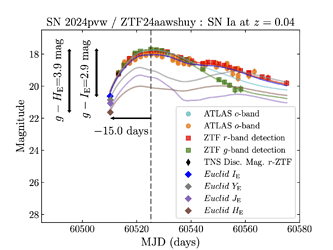Euclid is an ESA space telescope well suited to the observation of transients due to its excellent spatial resolution and NIR capabilities. In the Euclid Supernovae and Transients Science Working Group’s first science paper using Euclid Q1 data, we used Euclid to study transients which had been identified by other surveys, including ZTF.
Our primary goal was to demonstrate that Euclid could add useful scientific value to the study of transients by supplementing observations from ground-based surveys with those from Euclid. Some of the areas where Euclid can be useful include: adding early time observations to constrain explosion time or identify precursor activities; late time observations that can provide information of the transient power source and its environment; “orphan” transient observations where Euclid’s greater depth can reveal host galaxies.
In combining Euclid with ground-based data, we relied on Lasair when working with ZTF data. Lasair allowed us to easily access the ZTF photometry to build combined light curves with Euclid Photometry. The ability to really get science-ready photometry measurements using Lasair sped up our analysis substantially and allowed us to draw meaningful scientific conclusions about a number of different transients.
Above: combined ZTF-ATLAS-Euclid lightcurve of the type Ia supernova 2024pvw. This represents one of the earliest NIR observations of a SN, 15 days before peak and ~3 days before the first ground-based detection. Early observation is essential for understanding the birth channels of SN Ia. For example, early flux excess in Type Ia SNe is observed in 20–30% of Type Ia SNe and they are linked to the existence of a red-giant companion, a dense circumstellar medium, or a helium detonation. Adding the NIR coverage also allows us to probe the presence of could come from heated material of the white dwarf, or a companion star, or a pre-existing accretion disc.
We also used Lasair to select “orphan” transits via the classifications provided by Sherlock; this allowed us to select those transients which did not have a host where Euclid may be able to add an association. Of the 11 “orphans” in our sample of transients, we were able to identify host galaxies for five of these.
With the start of regular Rubin operations, we expect there will be more than an order of magnitude increase in the number of transients which can be studied with Euclid. It will be essential for us to have the tools that a broker such as Lasair can provide to accurately filter alerts of interest and serve the data associated with these ready to use and combine with Euclid observations.
You can read the paper, published in the Euclid Q1 Special Edition of A&A: Euclid: Quick Data Release (Q1) – Photometric studies of known transients
